Note: I have a long backlog of posts to be made, some dating back to 2005. In order to give them some time above the fold, I'll be posting them using the current date and then backdating them after a week or so to put them in proper chronological order.
Friday, July 18, 2008
Art is Where You Find It
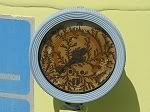 Here's an interesting corrosion pattern seen on a gauge on a piece of old fire fighting equipment at the small museum at Logan County (KAAA). It looks like some artsy-craftsy person painted a very intricate clinging vine motif on the face of the instrument, inside the glass.
Here's an interesting corrosion pattern seen on a gauge on a piece of old fire fighting equipment at the small museum at Logan County (KAAA). It looks like some artsy-craftsy person painted a very intricate clinging vine motif on the face of the instrument, inside the glass.
Saturday, July 05, 2008
Independence Day
A common discussion topic on the web boards around this time of year concerns the worthwhileness of watching fireworks displays from the air. The consensus seems to be that it's not worth the effort since the airbursts take place at low altitudes and tend to get lost amidst the lights on the ground. You also miss the sounds of the explosions since you are probably wearing a noise-canceling headset to protect your ears from the effects of being wrapped in an aluminum shell that's being vibrated by at least 83 little explosions per second and pummeled by an equal number of prop blades.
My own experience tended to bear this out. I've seen fireworks from the air a few times before - typically smallish displays seen from a distance while cruising at about 5,000 feet - and they were novel, but not particularly impressive. I've typically spent the Fourth of July on the ground, usually as part of a band of some sort playing for the festivities, but this year I found myself gigless. With nothing else on the schedule, I decided to take Yellowbird out to see if we could see anything from aloft.
I departed about 45 minutes before sundown. I hadn't really planned things out, so this gave some time to scope out where the displays might be found. Bloomington lies under the class Delta airspace for KBMI, so I decided to check out some of the smaller towns in the area. From experience. I knew that school athletic fields are popular sites for fireworks displays and are easy to spot from the air. I checked out a few of the nearby towns until I found one where cars seemed to be gathering around the local school. I then hung out at a comfortable altitude and waited for sundown.
As darkness fell, sporadic small displays erupted all across town. I sometimes headed over for a closer look, practicing turns around a point over someone's back yard barbecue until they stopped firing things up. I figured that they might enjoy a little airshow with their fireworks, but it later occurred to me that they might have thought that I was some sort of airborne fireworks patrol and that the authorities would soon drive up and shut down their festivities. But as it turns out, fireworks are apparently so legal around here that it's hard to find a supermarket that isn't selling them at this time of year. We may not have scenery, but Americana is still alive and well.
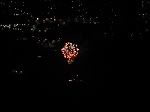 Some time after dark, the show started in earnest. I set up a left hand pattern at about 1,500 AGL and about half a mile to a mile radius from the launch site. Best results were with a gentle bank angle (about half standard rate). Winds were calm, so once trimmed for level flight in the turn, I had a pretty stable perch and only small adjustments were needed to stay on station.
Some time after dark, the show started in earnest. I set up a left hand pattern at about 1,500 AGL and about half a mile to a mile radius from the launch site. Best results were with a gentle bank angle (about half standard rate). Winds were calm, so once trimmed for level flight in the turn, I had a pretty stable perch and only small adjustments were needed to stay on station.
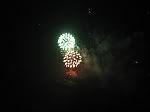 The resulting view was more that I expected. In short, it was spectacular.
The resulting view was more that I expected. In short, it was spectacular.
 The ground lights were not bright enough to overpower the fireworks, and from a reasonable altitude and distance, they were just as brilliant as when seen from the ground.
The ground lights were not bright enough to overpower the fireworks, and from a reasonable altitude and distance, they were just as brilliant as when seen from the ground.
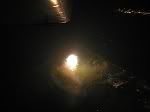 No mosquitoes to deal with, and no crowds either.
No mosquitoes to deal with, and no crowds either.
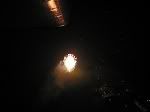 I didn't have to hunt for my car in a vast field of parking, and there was no traffic to fend off during the drive home.
I didn't have to hunt for my car in a vast field of parking, and there was no traffic to fend off during the drive home.
 Of course I couldn't hear them go off, but visually, I had the best seat in the house.
Of course I couldn't hear them go off, but visually, I had the best seat in the house.
A few caveats:
- Maneuvering flight at low altitudes carries a number of unique risks. Among these are the tendency to get distracted by things on the ground to the detriment of situational awareness aloft. A pilot's number one priority is flying the airplane, but still many pilots have come to grief trying to circle an object of interest on the ground (the dreaded Moose Hunter Stall). Maintaining airspeed, attitude and coordinated flight are more important than keeping some bombs bursting in air in sight. The fireworks aren't going anywhere, so you can always come around for another view if you drift off of your pattern. You probably won't get a second chance in a stall/spin at low altitude.
- I had the sky to myself, but I've heard others relate seeing up to six airplanes watching a fireworks show. That many airplanes in one area can be a recipe for disaster, particularly if one or more pilots are distracted by watching things on the ground. Surprisingly a search of the NTSB accident database shows no midair accidents (or any accidents, for that matter) in the vicinity of fireworks displays, and only one accident that was in any way related to fireworks. (The pilot could not see the airport due to darkness and the intensity of a nearby fireworks display, so he diverted to an open field where he misjudged his approach, in part because he had no landing light.) Still traffic avoidance should be a top priority. I kept my eyes open, my landing light on, and the radio tuned to the CTAF frequency of the local airport.
- The show was on the outskirts of town, so at times there were not enough lights visible for good ground reference. And it was slightly hazy, so there was no visible horizon. Added to these factors are the bright lights of the fireworks, and spatial disorientation became a real risk. I made a point of periodically looking at recognizable ground features (brightly lit intersections, etc.) to keep my bearings. I also looked at the panel from time to time to check altitude, attitude and engine performance.
Sunday, December 30, 2007
Yellowbird's Broken Heart
During her 2007 annual airworthiness inspection, Yellowbird was diagnosed with a cracked engine crankcase. The treatment required removing the engine and shipping it to an engine shop in New York where it was rebuilt around a replacement crankcase. In the interim, Yellowbird sat in the corner of the FBO hangar while I treated her to a few upgrades and makeovers. There were delays and concerns aplenty, but after five months, she was finally restored to health. Here's the complete story of our grand misadventure:
- Cracked: This is where it all began. An otherwise trouble free annual inspection turns into a five month stay in the maintenance hangar.
- Enginectomy: What does it take to remove a typical light plane engine?
- Housework: Finding opportunity in adversity, I paint various airplane parts that were removed when the engine was pulled.
- SCAT: A kind of vocal improvisation common in jazz.
- Painting the Engine Room (Part 1, Part 2): The lower engine cowling gets a makeover.
- Bachelor Life: How to spend a lonely Friday night.
- It's Here!: After a month's delay, the rebuilt engine finally arrives.
- Parts: A shopping list of things replaced during the rebuild.
- Upgrades: Taking advantage of Yellowbird's disassembled condition, I order an engine monitor and preheater.
- It Flies! (sort of): The engine is hoisted aloft while the preheater is installed.
- Hanging the Engine (Day 1, Day 2, Day 3): Yellowbird comes back together.
- Delay, Again: One last gremlin rears its ugly head.
- First Run: Yellowbird sings for the first time in five months.
- The Annual Report - 2007: What did it take to restore Yellowbird to airworthiness?
- Leftovers: Paperweights, strange jewelry, and the Bachelor Pilot Table Setting.
- Aloft at Last: Yellowbird finally takes to the air!
Saturday, December 29, 2007
Aloft at Last
METAR KBMI 292056Z 22006KT 10SM OVC016 M01/M04 A3007 RMK AO2 56013 T10111038 SLP203
Translation: Wind: blowing from 220° at 6 knots; Visibility: 10 statue miles; Sky condition: overcast at 1,600 feet above ground level; Temperature: -1°C; Dewpoint: -4°C
Not the best conditions, and they were barely VFR, but it was worth a try just to get in the air again for our first flight after five months in the shop due to a cracked crankcase.
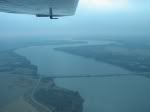 After a bit of confusion during runup (I mistook the new mixture control for the prop control) I actually remembered how to takeoff and we were finally airborne. Break-in instructions call for running the engine at generally high power setting (above 65%) so as to seat the piston rings. I ran her at 23 inches of manifold pressure and 2,500 RPM, which under standard conditions would be roughly 75%. Cold temperatures typically mean higher performance for a given power setting, and although I don't know eaxctly how much that impacted the horsepower percentage, it was definitely reflected in the airspeed. In level flight, I was operating in the caution range (the yellow arc on the airspeed indicator, from 155 - 185 MPH) for much of the flight.
After a bit of confusion during runup (I mistook the new mixture control for the prop control) I actually remembered how to takeoff and we were finally airborne. Break-in instructions call for running the engine at generally high power setting (above 65%) so as to seat the piston rings. I ran her at 23 inches of manifold pressure and 2,500 RPM, which under standard conditions would be roughly 75%. Cold temperatures typically mean higher performance for a given power setting, and although I don't know eaxctly how much that impacted the horsepower percentage, it was definitely reflected in the airspeed. In level flight, I was operating in the caution range (the yellow arc on the airspeed indicator, from 155 - 185 MPH) for much of the flight.
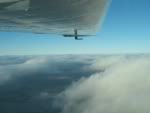 It was pretty murky below the overcast, but as we continued around the area, the skies began to clear a bit and I found holes large enough to allow a peek above the cloud layer. I wouldn't wasn't to have to descend through those clouds - the layer wasn't that thick, but at a few degrees below freezing, ice would be a problem. I kept a careful eye on the hole.
It was pretty murky below the overcast, but as we continued around the area, the skies began to clear a bit and I found holes large enough to allow a peek above the cloud layer. I wouldn't wasn't to have to descend through those clouds - the layer wasn't that thick, but at a few degrees below freezing, ice would be a problem. I kept a careful eye on the hole.
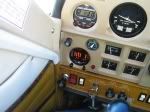 The engine monitor in action. Cylinder #3 is running a bit leaner than the other cylinders, but that is supposedly normal for this engine. What is curious is that the cylinder head temperature for #3, which typically runs hotter than the others, is significantly cooler. This may be due to the fact that #3 has a different type of temperature probe which allows the EDM-700 and the factory cylinder head temperature gauge to read from the same socket on the cylinder head. The numeric readout "23 IAT" is the carburetor inlet temperature. The manual indicates that this should read "CRB" instead of "IAT" (which stands for Induction Air Temperature, a measure of the temperature of air entering the intercooler of a supercharged engine) We had issues with the connectors of the wiring harness during installation of the EDM-700, so this may be another mismatched connector.
The engine monitor in action. Cylinder #3 is running a bit leaner than the other cylinders, but that is supposedly normal for this engine. What is curious is that the cylinder head temperature for #3, which typically runs hotter than the others, is significantly cooler. This may be due to the fact that #3 has a different type of temperature probe which allows the EDM-700 and the factory cylinder head temperature gauge to read from the same socket on the cylinder head. The numeric readout "23 IAT" is the carburetor inlet temperature. The manual indicates that this should read "CRB" instead of "IAT" (which stands for Induction Air Temperature, a measure of the temperature of air entering the intercooler of a supercharged engine) We had issues with the connectors of the wiring harness during installation of the EDM-700, so this may be another mismatched connector.
 Here's the graph of the flight downloaded from the EDM-700 and displayed in JPI's EzTrends program. The top lines show the exhaust gas temperatures plotted against the y-axis scale on the left of the chart. The bottom lines show cylinder head temperatures plotted against the y-axis scale on the right. Flight events such as engine start and warm-up, takeoff and climb, level-off, landing, and the long taxi back to the ramp are evident. The major spikes in the EGT graph correspond to mixture adjustments I made while exploring the EDM-700's lean-find function, and a few in-flight magneto checks.
Here's the graph of the flight downloaded from the EDM-700 and displayed in JPI's EzTrends program. The top lines show the exhaust gas temperatures plotted against the y-axis scale on the left of the chart. The bottom lines show cylinder head temperatures plotted against the y-axis scale on the right. Flight events such as engine start and warm-up, takeoff and climb, level-off, landing, and the long taxi back to the ramp are evident. The major spikes in the EGT graph correspond to mixture adjustments I made while exploring the EDM-700's lean-find function, and a few in-flight magneto checks.
 After 2.3 hours in the air, it was time to come home again. I still remember how to land a Cardinal. It was basically a trouble free flight, and the only squawk (apart from the IAT/CRB readout) was an oil leak which was easily diagnosed and fixed.
After 2.3 hours in the air, it was time to come home again. I still remember how to land a Cardinal. It was basically a trouble free flight, and the only squawk (apart from the IAT/CRB readout) was an oil leak which was easily diagnosed and fixed.
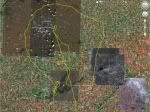 Here's where we went, according to the GPS track downloaded and shown in Google Earth.
Here's where we went, according to the GPS track downloaded and shown in Google Earth.
